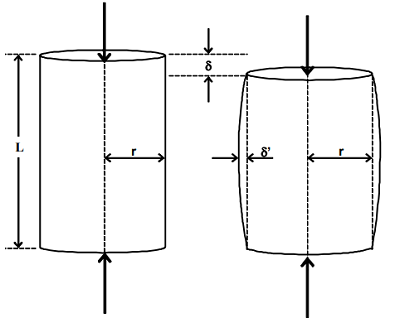Related Resources: materials
Poisson's Ratio Metals Materials Chart
Strength of Materials | Engineering Metals & Materials
The following is a chart of Poisson's Ratio for common engineering materials and metals.
When a compressive force acts on a cylinder body, the force causes the sample to contract in the direction of the force and expand laterally. Within the elastic range of the material, the ratio of these strains is a constant for that particular material. The ratio of the strains, (δ/L) for longitudinal strain and (δ'/r) for lateral strain, is referred to as Poisson's ratio.


Poisson's Ratio Equation & Definition
| Material | Poisson's Ratio |
| Aluminum alloy |
0.32 |
| Aluminum, 6061-T6 | 0.35 |
| Aluminum, 2024-T4 | 0.32 |
| Beryllium Copper | 0.285 |
| Brass | 0.331 |
| Brass, cast | 0.357 |
| Bronze | 0.34 |
| Cast iron | 0.21 - 0.26 |
| Clay | 0.30 - 0.45 |
| Concrete | 0.200 |
| Copper | 0.330 |
| Cork | ~ 0.00 |
| Foam | 0.10 - 0.40 |
| Glass | 0.18 - 0.3 |
| Granite | 0.2 - 0.3 |
| Gold | 0.42 - 0.44 |
| Inconel | 0.27 - 0.38 |
| Iron, Cast | 0.22 - 0.30 |
| Iron, Cast - gray | 0.211 |
| Iron, Ductile | 0.26 - 0.31 |
| Iron, Malleable | 0.271 |
| Limestone | 0.2 - 0.3 |
| Magnesium | 0.350 |
| Magnesium Alloy | 0.281 |
| Material | Poissons Ratio |
| Molybdenum | 0.307 |
| Monel | 0.320 |
| Nickel | 0.310 |
| Nickel Silver | 0.322 |
| Nickel Steel | 0.291 |
| Polystyrene | 0.340 |
| Phosphor Bronze | 0.359 |
| Platinum | 0.380 |
| Rubber | ~ 0.550 |
| Sand | 0.20 - 0.45 |
| Saturated clay | 0.40 - 0.49 |
| Stainless steel | 0.30 - 0.31 |
| Steel | 0.27 - 0.30 |
| Steel, cast | 0.265 |
| Steel, Cold-rolled | 0.287 |
| Steel, high carbon | 0.295 |
| Steel, mild | 0.303 |
| Titanium | 0.340 |
| Wrought iron | 0.278 |
| Z-nickel | 0.360 |
| Zinc | 0.331 |